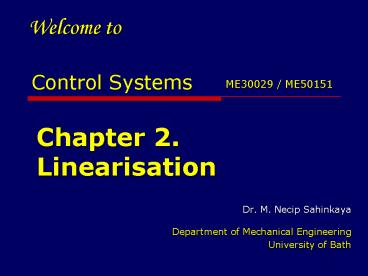Control Systems - PowerPoint PPT Presentation
1 / 16
Title:
Control Systems
Description:
The analysis and design techniques developed for linear ... Coulomb friction with stiction & viscous friction. Saturation. Backlash. Dr. M.Necip Sahinkaya ... – PowerPoint PPT presentation
Number of Views:118
Avg rating:3.0/5.0
Title: Control Systems
1
Control Systems
Welcome to
ME30029 / ME50151
Chapter 2. Linearisation
- Dr. M. Necip SahinkayaDepartment of Mechanical
Engineering - University of Bath
2
Introduction
- The analysis and design techniques developed for
linear systems are more complete, more reliable
and much simpler than they are for nonlinear
systems. - This is the incentive to try to linearise
non-linearities within the neighbourhood of
particular operating condition if the
non-linearities are not severe. - Non-linearities can be classified as
- Static
- Dynamic
3
Static Non-Linearities
- If the nonlinearity is between the input and
output that does not involve a differential
equation is called static nonlinearity - Continuous non-linearity.
- Some non-linear elements exhibit static
discontinuities
4
Static continuous non-linearity
Nonlinear mechanical spring (a) Hardening (b)
Softening
5
Static discontinuous non-linearities
Coulomb friction
Coulomb friction with stiction viscous friction
Backlash
Saturation
6
Small Perturbations
For static continuous non-linearities
Taylor Expansion (Series)
Ignoring higher order terms
7
Example flow through orifice
Assuming the output is open to atmosphere (P2
0), and small changes of the input pressure
around P0 (i.e. P1 P0 ?P1)
Alternatively
8
Example flow through orifice -2-
If the output pressure was also variable, then
the flow would be function of two variables, P1
and P2. Then the linearised equation around an
operation point P1 P1o p1 and P2 P2o p2
could be obtained as
9
Dynamic Non-linearities
10
Linearisation of dynamic equations-Ex.1
For small values of y, sin y(t) y(t) can be
assumed,
Corresponding u at the steady operating point is
0. Ignoring higher order terms
11
Linearisation of dynamic equations-Ex.2
Taking h0 as the operating point, the
corresponding control current i0 can be
calculated by using the steady state equations
(i.e. setting derivatives to zero)
12
Linearisation of dynamic equations-Ex.3
13
Complete Example
14
Complete Example contd
15
Complete Example contd
Consider the case with X is constant (x0).
16
End of Section 2
- gtgtLinearisation
Thank you
Dr. M. Necip Sahinkaya Department of Mechanical
Engineering University of Bath































